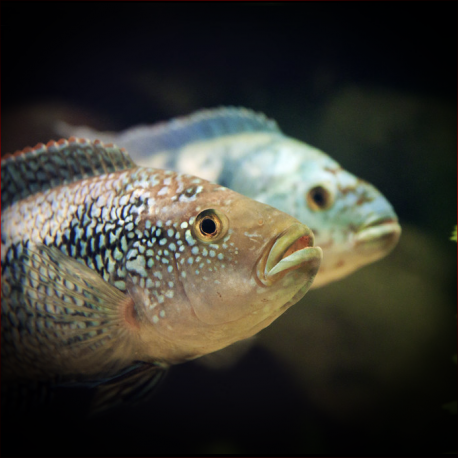More info
Datasheet
| Minimum Tank Size | 240 litres / 63.40 US gallons |
| Maximum Size | 20.0cm / 7.87inches |
| Temperature | 20°C / 68.00°F - 30°C / 86.00°F |
| Hardness | 5.04dgH / 90ppm - 20.00dgH / 357ppm |
| pH | 6.5-8.0 |
General DescriptionThe Jack Dempsey Cichlid, scientifically known as Rocio Octofasciata, is a member of the Cichlidae family. It was named after the American heavyweight boxer Jack Dempsey due to its strong facial features and pugnacious nature. This fish has a confusing taxonomic history and has been classified under various genera before being placed in the genus Rocio in 2007.
Aquarium SetupFor optimal care, the Jack Dempsey Cichlid requires a minimum tank size of 240 liters. The ideal tank setup includes a soft, sandy substrate, water-worn rocks for potential spawning sites, dim lighting, driftwood, and scattered roots or branches. Live plants that can grow attached to decor or float on the surface are recommended as rooted plants may be uprooted by the cichlid's digging behavior. Maintaining good water quality is essential for the well-being of these fish, as they are sensitive to deteriorating water conditions.
BehaviourJack Dempsey Cichlids can be kept in a well-chosen community setup with tankmates that are too large to be considered prey, although a large tank is required if kept with other cichlids. Young specimens can coexist but may exhibit aggression as they mature. If a pair forms, they are typically peaceful towards each other but aggressive towards other conspecifics and similarly-shaped fish.
Feeding and DietIn the wild, Jack Dempsey Cichlids are omnivorous, with a preference for aquatic invertebrates. In captivity, they thrive on a varied diet that includes sinking dried foods, frozen Daphnia, mosquito larvae, bloodworms, prawns/shrimp, and homemade foods containing a mix of natural ingredients like fresh fruit, vegetables, Spirulina, and meat.
Reproduction & DimorphismThese cichlids are biparental substrate spawners. They exhibit aggressive behavior during mating and become defensive of their nesting sites and offspring. Male and female Jack Dempsey Cichlids can be distinguished by subtle differences in coloration and fin extensions, with males usually being slightly larger and more brightly colored than females.
Habitat and DistributionNative to the Atlantic slope of Central America, Jack Dempsey Cichlids can be found in Mexico, Belize, Guatemala, and Honduras. They inhabit coastal drainages, rivers, canals, ditches, lakes, and ponds. Feral populations of this species have been established in countries such as the United States, Russia, Australia, and Thailand.

